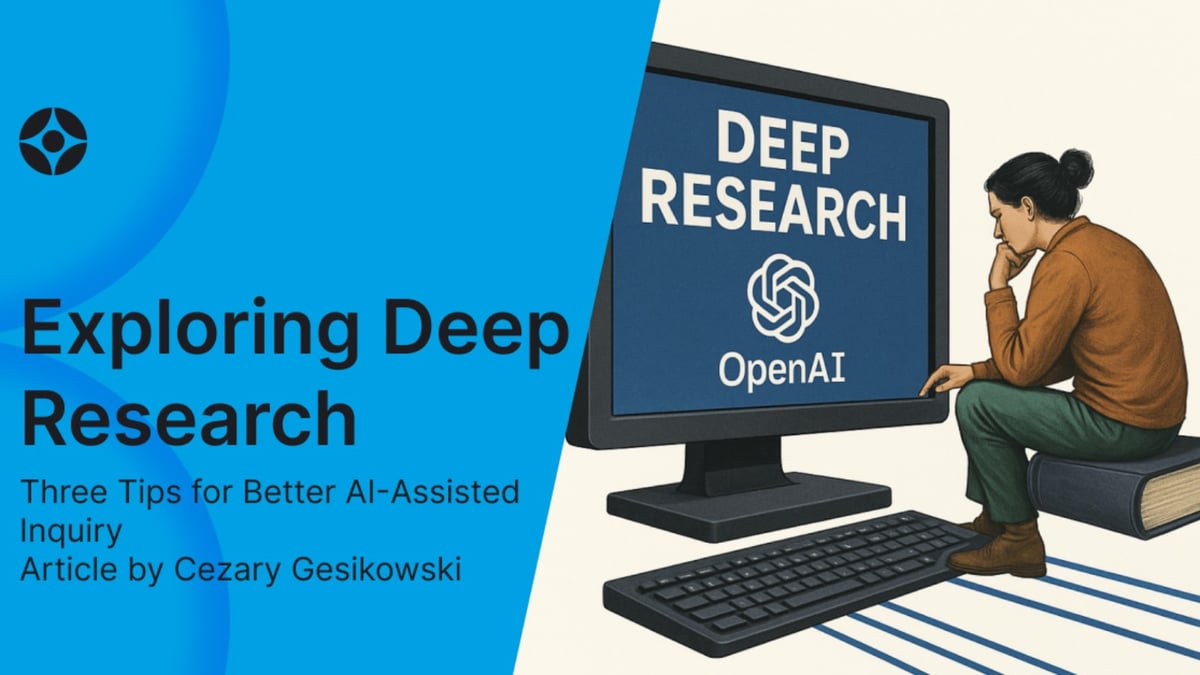Research
April 29, 2025
Exploring Deep Research: Three Tips for Better AI-Assisted Inquiry

# AI Research
# o3 reasoning model
# Deep Research
By Cezary Gesikowski | For OpenAI Forum

Cezary Gesikowski

I've been using Deep Research since its February 2025 debut for ChatGPT’s paid users, and it's a remarkable tool. For example, a simple query (“How can the agriculture and food sector reduce household food insecurity?”) provides – in mere minutes – a range of policy, technical, and region-specific insights, along with a comprehensive list of resources that typically take researchers hours to gather as a starting point for more in-depth analysis.
So when the OpenAI Forum announced a session featuring Isa Fulford and Zhiqing (Edward) Sun — the researchers who helped bring Deep Research to life — I jumped at the opportunity. Their presentation provided both clarity and inspiration, deepening my appreciation of the model's capabilities.
Deep Research, powered by OpenAI's sophisticated o3 reasoning model, is groundbreaking. It can autonomously handle intricate, long-form research across numerous online sources. Its 'agentic' qualities enable it to independently browse, analyze, and synthesize vast amounts of information, delivering detailed, well-cited reports. Isa and Edward highlighted how Deep Research can now complete tasks that typically demand hours or even days of human effort in mere minutes.
"Deep Research is an agent in ChatGPT that can do work for you independently. You give it a prompt, and it will find, analyze, and synthesize hundreds of online sources to create a comprehensive report at the level of a research analyst." — Isa Fulford, Deep Research in the OpenAI Forum presentation
Yet, perhaps most helpful for someone like me, Isa and Edward provided tips on how to better use Deep Research and its powerful capabilities. Here are three of their tips.
1. Clearly define your research objective
During the presentation, Edward shared his advice on prompting Deep Research: clearly state your research objectives while allowing the model creative freedom to find the best solution. This approach, though counterintuitive, enhances the model's performance by leveraging its inherent strengths.
This was enlightening to me, as I'd previously used extensive and detailed prompts — sometimes leveraging other models like o1 PRO to craft elaborate meta-prompts of more than 1,000 words. Edward's guidance underscored the importance of trusting the model's inherent strengths.
"There are ways to prompt these reasoning models [where], rather than instruct the model how to perform the task, you should tell the model the objective of your task. The model is usually more creative because it knows its constraints and may find some ways to complete the task more effectively." — Zhiqing (Edward) Sun, Deep Research in the OpenAI Forum presentation
2. Plan your prompts ahead – and revise them as you go
Deep Research has already saved me a lot of time in numerous projects that involved a lot of digging around the internet and academic repositories. However, I particularly value how conversational and responsive the model is in Deep Research mode. Considering that responses take time, I found myself constructing prompts carefully, sometimes meta-prompting using the o1 PRO model (which now can be done more efficiently with o3 or o4-mini for faster results).
Rather than simply responding to prompts, Deep Research often initiates follow-up questions to ensure the research results precisely match users' intentions. This interactive element significantly enhances the relevance and accuracy of its outputs.
Additionally, Isa clarified an important detail regarding the underlying technology I found slightly confusing: regardless of your conversation model selection (like 4o or o1 PRO), Deep Research consistently utilizes the fine-tuned o3 model. Different initial model choices might still matter practically — faster-reacting models like 4o can be handy for refining prompts and engaging in preliminary interactions.
At the same time, Deep Research provides thorough, deliberate results. Given Deep Research's reasoning-heavy processing style, however, she suggested that faster-reacting models benefit initial prompt refinement. This confirmed my earlier approaches using iterative and meta-prompting to articulate my instructions.
3. Avoid over- (and under-)instructing the model
The OpenAI Forum session delivered a real gold nugget that has improved my approach by adding an extra step at the end of my meta-prompting to avoid over-instructing the Deep Research mode for the best results. Yes, you guessed it: I iterated the prompt with ChatGPT to arrive at a concise meta-prompt you can use to evaluate your prompts for optimal use with the fine-tuned o3 model in Deep Research mode:
"Review the following prompt to determine if it strikes an optimal balance for Deep Research with the o3 model. Evaluate whether it clearly articulates the research objective without imposing excessive constraints or leaving too much ambiguity. Suggest specific adjustments if it appears over-instructed or under-instructed, ensuring maximum accuracy, creativity, and effectiveness."--Meta Prompt suggested by ChatGPT-4.5
I was inspired by Edward’s earlier comment about ‘trusting the model’ when deciding the best research path for itself. Note that the model added a range of caution for under-instruction, which is less of a problem for most avid prompters than it was in the early days of ChatGPT. Though under instruction (not giving the model enough detail in the prompt) is not as big of an issue with Deep Research now, as there is a verification step that the mode engages to confirm important details with the user before launching an extensive research session.
Ongoing Deep Research improvements
Isa and Edward also shared that Deep Research's adoption and applications have surpassed OpenAI's expectations. Interestingly, it has found robust use in coding, especially for accessing current APIs and libraries. It’s also been notably welcomed in medical and biological research communities, with experts confirming its outputs' reliability.
But they openly discussed the model's limitations, too – such as occasional factual inaccuracies and challenges differentiating between authoritative and less credible sources. But Isa and Edward assured us that OpenAI is continuously working on enhancements, including rigorous safety measures, red teaming, and governance protocols. These are increasingly important issues, and despite the rumour mill, safety remains an important pre-release and ongoing aspect of model development at OpenAI.
"… regarding safety, we did extensive safety training and evaluation before launching this model. We had new safety data and training data in a few categories. … Before release, we did extensive red teaming with external testers. Then, we reviewed the preparedness and governance reviews we always do at OpenAI." — Isa Fulford, Deep Research in the OpenAI Forum presentation.
Summary of My Top 3 Deep Research Tips
Here is the summary of the top three tips for best results in Deep Research mode:
- Tip 1 – Clearly define your research objective: Provide the model with a precise and focused objective to keep the research targeted and relevant.
- Tip 2 – Plan your prompts ahead and the revise them as you go: Use iterative and meta prompting: Start with broader prompts and progressively refine your questions based on initial responses to guide the model more effectively and uncover deeper insights. This works well for meta prompting in o3 or o4 to land on the best prompt for Deep Research mode. Note that 4.5 works well for this, too.
- Tip 3 - Avoid over-instructing the model: Provide sufficient guidance without excessive constraints. Too many details or overly rigid instructions can limit creativity and reduce the accuracy and depth of insights. Keep your prompts balanced—clear enough for precision and flexible enough for exploration. Deep Research mode will provide a clarification request to finalize the research parameters before commencing research if anything needs clarification.
To learn more about Deep Research, follow these links:
I'm particularly curious what you think of the following questions. If you are a member of the OpenAI Forum, leave your answers in the comments. Also, feel free to add any questions — you never know who might be listening!
- How might Deep Research revolutionize your professional or academic workflows?
- What features would enhance its usefulness for your specific research needs?
- How can OpenAI ensure that Deep Research maintains consistently high ethical and accuracy standards?
7
Comments (4)
Popular
Dive in
Related
57:10
video
Event Replay: Learning Powerful Models: From Transformers to Reasoners and Beyond
By Lukasz Kaiser • Oct 8th, 2025 • Views 974
57:10
video
Event Replay: Learning Powerful Models: From Transformers to Reasoners and Beyond
By Lukasz Kaiser • Oct 8th, 2025 • Views 974

